Lecture 2-DATABASE MODELS lecture 2.pptx
Download as PPTX, PDF0 likes37 views
Database management system notes
1 of 21
Download to read offline
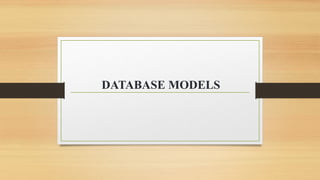
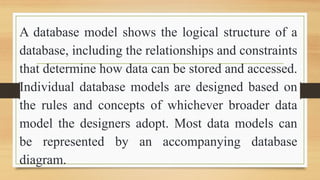
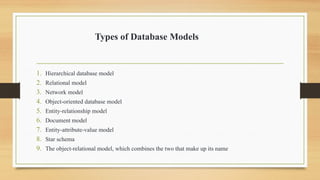
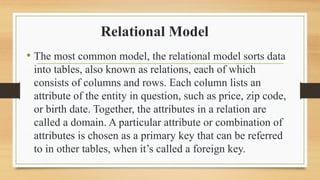
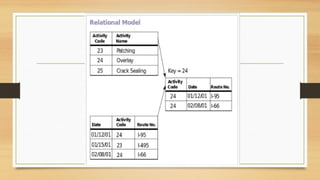
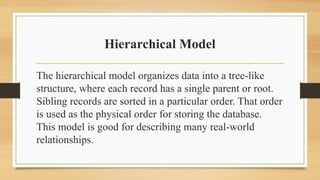


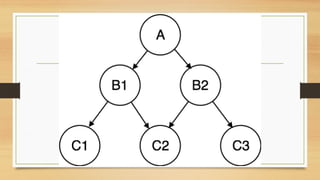


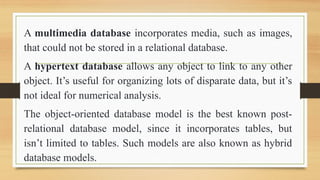

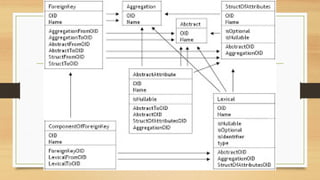
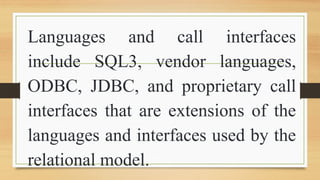

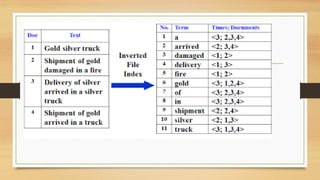
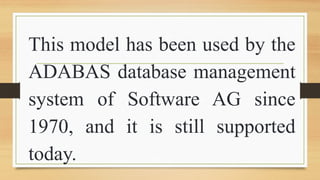
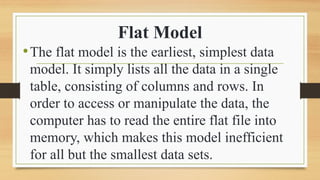


Ad
Recommended
2. Chapter Two.pdf
2. Chapter Two.pdffikadumola
?
The document discusses database system architecture and data models. It introduces the three schema architecture which separates the conceptual, logical and internal schemas. This provides logical data independence where the conceptual schema can change without affecting external schemas or applications. It also discusses various data models like hierarchical, network, relational and object-oriented models. Key aspects of each model like structure, relationships and operations are summarized.DIFFERENT MODELS IN DBMS.pptx
DIFFERENT MODELS IN DBMS.pptxKavya990096
?
The document discusses several database management system (DBMS) models:
- Relational, network, hierarchical, object-oriented, and object-relational models are described as the main DBMS models.
- Key aspects of each model are covered, including data structure, relationships, querying capabilities, and advantages/disadvantages.
- Examples are provided for the relational model in the form of a sample table and for the hierarchical model in terms of its data structure and relationships.
- Overall the document provides a high-level overview and comparison of the main DBMS models.Student POST ?Database processing models showcase the logical s.docx
Student POST ?Database processing models showcase the logical s.docxorlandov3
?
The document discusses various database processing models, highlighting the relational, object-oriented, entity-relationship, network, and hierarchical models. Each model has its advantages, such as ease of understanding and handling complex data, as well as disadvantages like cost, complexity, and limitations in representation. It emphasizes the importance of understanding these models for effective database management and application development.data base system to new data science lerne
data base system to new data science lernetarunprajapati0t
?
Databases are organized collections of data that allow for efficient data access and management. There are different types of databases including relational databases, NoSQL databases, object-oriented databases, and graph databases. Databases have evolved over time from flat file systems to hierarchical, network, relational, and modern cloud-based systems. A database management system provides tools for creating, accessing, and managing databases and ensures security, integrity, and consistency of stored data.Data models
Data modelsSamuel Igbanogu
?
The document outlines data modeling, including its definition, types, and significance. It describes various approaches such as conceptual, logical, and physical data modeling, as well as different data models like flat, hierarchical, and relational models. Additionally, it emphasizes the importance of data models in facilitating communication and organization within databases.DBMS
DBMSRai Saheb Bhanwar Singh College Nasrullaganj
?
This document provides an overview of different data models, including object-based models like the entity-relationship model and object-oriented model, and record-based models like the relational, network, and hierarchical models. It describes the key features of each model, such as how data and relationships are represented, and highlights some advantages and disadvantages. The presentation is intended to guide students in understanding different approaches to database design and logical data modeling.DBMS OF DATA MODEL Deepika 2
DBMS OF DATA MODEL Deepika 2Rai Saheb Bhanwar Singh College Nasrullaganj
?
This document provides an overview of different data models, including object-based models like the entity-relationship model and object-oriented model, and record-based models like the relational, network, and hierarchical models. It describes the key features of each model, such as how data and relationships are represented, and highlights some of their advantages and disadvantages. The presentation aims to guide students in understanding different approaches to database design and modeling.Data models
Data modelsHira Bukhari
?
The document discusses several data models including flat file, hierarchical, network, relational, object-relational, and object-based models. It provides details on the flat file model, describing it as a single two-dimensional array containing data elements in columns and related elements in rows. The object-relational model combines relational and object-oriented features, allowing integration of databases with object-oriented data types and methods. The document also discusses the entity-relationship model, which is an object-based logical model that uses entities, attributes, and relationships to flexibly structure data and specify constraints.Data models
Data modelsHira Bukhari
?
The document discusses several data models including flat file, hierarchical, network, relational, object-relational, and object-based models. It provides details on the flat file model, describing it as a single two-dimensional array containing data elements in columns and related elements in rows. The object-relational model combines relational and object-oriented features, allowing integration of complex data types. The object-based model uses entities, attributes, and relationships, with the entity-relationship model being a commonly used object-based logical model.Databases and its representation
Databases and its representationRuhull
?
The document is an overview of databases, explaining definitions, types, and functionalities like DBMS, database models, and data integrity. It highlights the relational database model introduced by E.F. Codd in 1970, detailing its structure, advantages, and use of SQL. Additionally, it discusses the evolution towards post-relational databases and the emergence of NoSQL and NewSQL systems.Presentation1
Presentation1Celso Catacutan Jr.
?
Object databases store objects rather than data types like numbers and strings. Objects have attributes that define their characteristics and methods that define their behaviors. Relational databases store data in normalized tables with rows and columns. Object databases are suited for complex data and relationships, while relational databases work better for large volumes of simple transactional data.
The Entity-Attribute-Value model is a semi-structured data model where each attribute-value pair describing an entity is stored as a single row. This flexible model allows for an unlimited number of attributes per entity.Data models and ro
Data models and roDiana Diana
?
- A data model is an abstraction that represents real-world objects and their relationships to help describe an organization's data requirements. It includes concepts for describing data, relationships between data, and constraints on the data.
- Early data models included the hierarchical and network models, which used pointers to represent physical relationships between records. This led to issues like data redundancy and an inability to easily change relationships.
- The relational model was developed to address limitations of earlier models by using logical relationships without pointers. It represented a significant improvement over previous approaches.database-model group presentation.pptx
database-model group presentation.pptxRuksanKarki
?
The document outlines various database models, defining a database model as a set of rules for organizing data and user views. It details object-oriented, entity-relationship, relational, and network models, each with specific structures and concepts for managing data. Key terms like entities, attributes, primary keys, and normalization are also explained in relation to these models.WEB_DATABASE_chapter_4.pptx
WEB_DATABASE_chapter_4.pptxKoteswari Kasireddy
?
Web databases refer to databases that are accessed or manipulated via the world wide web. They are used to store information for websites, web apps, and mobile apps. There are two main categories of web databases: relational databases like MySQL use schemas and SQL, while non-relational databases like MongoDB are more flexible and don't require predefined schemas. Relational databases are better for applications needing complex queries, while non-relational databases are more scalable and flexible for handling large, unstructured data.Database systems introduction
Database systems introductionBalasingham Karthiban
?
Database systems can be summarized in 3 sentences:
A database system consists of a database, database management system (DBMS), and users. The database contains organized data, the DBMS manages access to the data and provides utilities for querying and updating it, and users interact with the system for data entry, retrieval, and administration. Over time, database models have evolved from hierarchical and network models to the prevalent relational model to better support data sharing and querying across systems.Dbms Lec Uog 02
Dbms Lec Uog 02smelltulip
?
The document discusses various database models including flat file, hierarchical, network, relational, object-relational, and object-based models. It provides a brief history of database development, from manual files to relational databases. It describes key aspects of relational databases including how data is organized into logical tables with rows and columns.Database System Concepts AND architecture [Autosaved].pptx
Database System Concepts AND architecture [Autosaved].pptxKoteswari Kasireddy
?
The document discusses key concepts in database systems and architecture. It defines what a data model is and describes different types of data models including high-level conceptual models, low-level physical models, and representation models. It also outlines several common data models like hierarchical, network, relational, object-oriented, and object-relational models. Finally, it provides a simplified overview of the key components of a database system, including the database, DBMS software, catalog, and users/applications.DBMS-Unit-1.pptx
DBMS-Unit-1.pptxBhavya304221
?
The document provides an overview of database management systems (DBMS). It discusses the need for DBMS, different database architectures including centralized, client-server and distributed. It also covers data models, ER diagrams, relational models, and SQL. Key advantages of DBMS over file systems include reducing data redundancy, improving data integrity and security, and enabling concurrent access.Basic SQL for Bcom Business Analytics.pptx
Basic SQL for Bcom Business Analytics.pptxsjcdsdocs
?
The document provides a comprehensive overview of Database Management Systems (DBMS), explaining its functions, advantages, and disadvantages, as well as common features and data models. It covers the relational data model and normalization processes, alongside the recent trends in databases, including cloud databases, NoSQL, and integration with AI and machine learning. Additionally, the document outlines various database administration tasks and SQL commands, emphasizing the role of database administrators in maintaining optimal database performance and security.Database
DatabaseRespa Peter
?
The document provides an overview of database models, describing how databases are organized for efficient data storage and retrieval. It explains various data models including hierarchical, network, relational, object-oriented, dimensional, and entity-relationship models, outlining their structures and relationships. Each model offers different methods for managing data and is suited for specific applications, illustrating the evolution and complexity of database management systems.DATABASE MANAGEMENT SYSTEM-MRS. LAXMI B PANDYA FOR 25TH AUGUST,2022.pptx
DATABASE MANAGEMENT SYSTEM-MRS. LAXMI B PANDYA FOR 25TH AUGUST,2022.pptxLaxmi Pandya
?
The document discusses database management systems and provides examples of different types of databases including relational, non-relational, centralized, distributed and object-oriented databases. It describes key components of databases like fields, records, tables and the core functions of adding, deleting, modifying and retrieving records. The document also explains concepts like database languages, database models, database examples, database features and integrity constraints.Dbms database models
Dbms database modelssanjeev kumar suman
?
This document discusses different database models including hierarchical, network, entity-relationship, and relational models. The hierarchical model organizes data in a tree-like structure with parent-child relationships. The network model extends the hierarchical model by allowing nodes to have more than one parent. The entity-relationship model divides data into entities and attributes and represents relationships visually. The relational model, introduced by E.F. Codd in 1970, organizes data into two-dimensional tables related through common fields and is the most widely used database model today.Data Models in Database Managment System
Data Models in Database Managment Systemtehzeebwzr
?
The document provides an overview of various data models used in database management systems, including relational, hierarchical, network, entity-relationship, object-oriented, and object-relational models. It discusses the definitions, advantages, and disadvantages of each model, along with their structural characteristics and usage scenarios. The importance of understanding these models for effective data organization and management in databases is emphasized.Whitepaper sones GraphDB (eng)
Whitepaper sones GraphDB (eng)sones GmbH
?
The document describes a new graph-oriented database called the sones GraphDB. It enables efficient storage, management, and analysis of complex, highly interconnected data. Unlike relational databases, it can directly link different types of data without additional constructs. The database combines a high-performance graph-oriented data management system with an object-oriented storage solution to allow flexible, real-time analysis of structured, semi-structured, and unstructured data.Data models
Data modelsThakshayini Chandramohan
?
The document discusses different data models including hierarchical, network, relational, object-oriented, and object-relational models. It provides details on each model's structure and advantages and disadvantages. It also discusses using the relational model for a database to manage information for the Fly High Airlines, including passenger, payment, and seat information. The relational model is justified as the best fit due to its ability to efficiently query and join table data while ensuring data integrity.Database Concepts & SQL(1).pdf
Database Concepts & SQL(1).pdfrsujeet169
?
The document discusses database concepts and SQL. It defines a database as an organized collection of related information. A database management system (DBMS) is software that allows users to create, access, manage and control databases. The major components of a DBMS are data, hardware, software and users. Different database models are discussed including hierarchical, network and relational models. Key aspects of the relational model like tables, rows, columns, primary keys and foreign keys are explained.Comprehensive Guide to Effective Data Model Principles
Comprehensive Guide to Effective Data Model PrinciplesEliasZerabruk
?
The document provides an overview of data models, describing their purpose, types, and the architecture of database systems. It explains the three levels of data models (external, conceptual, and internal), emphasizing the importance of data independence and schema mapping in facilitating changes without affecting user views. Additionally, it outlines the evolution of data models from hierarchical and network models to relational and object-oriented models.Measurecamp Copenhagen - Consent Context
Measurecamp Copenhagen - Consent ContextHuman37
?
Measurecamp Copenhagen 2025 presentation by Glenn Vanderlinden, Human37More Related Content
Similar to Lecture 2-DATABASE MODELS lecture 2.pptx (20)
Data models
Data modelsHira Bukhari
?
The document discusses several data models including flat file, hierarchical, network, relational, object-relational, and object-based models. It provides details on the flat file model, describing it as a single two-dimensional array containing data elements in columns and related elements in rows. The object-relational model combines relational and object-oriented features, allowing integration of databases with object-oriented data types and methods. The document also discusses the entity-relationship model, which is an object-based logical model that uses entities, attributes, and relationships to flexibly structure data and specify constraints.Data models
Data modelsHira Bukhari
?
The document discusses several data models including flat file, hierarchical, network, relational, object-relational, and object-based models. It provides details on the flat file model, describing it as a single two-dimensional array containing data elements in columns and related elements in rows. The object-relational model combines relational and object-oriented features, allowing integration of complex data types. The object-based model uses entities, attributes, and relationships, with the entity-relationship model being a commonly used object-based logical model.Databases and its representation
Databases and its representationRuhull
?
The document is an overview of databases, explaining definitions, types, and functionalities like DBMS, database models, and data integrity. It highlights the relational database model introduced by E.F. Codd in 1970, detailing its structure, advantages, and use of SQL. Additionally, it discusses the evolution towards post-relational databases and the emergence of NoSQL and NewSQL systems.Presentation1
Presentation1Celso Catacutan Jr.
?
Object databases store objects rather than data types like numbers and strings. Objects have attributes that define their characteristics and methods that define their behaviors. Relational databases store data in normalized tables with rows and columns. Object databases are suited for complex data and relationships, while relational databases work better for large volumes of simple transactional data.
The Entity-Attribute-Value model is a semi-structured data model where each attribute-value pair describing an entity is stored as a single row. This flexible model allows for an unlimited number of attributes per entity.Data models and ro
Data models and roDiana Diana
?
- A data model is an abstraction that represents real-world objects and their relationships to help describe an organization's data requirements. It includes concepts for describing data, relationships between data, and constraints on the data.
- Early data models included the hierarchical and network models, which used pointers to represent physical relationships between records. This led to issues like data redundancy and an inability to easily change relationships.
- The relational model was developed to address limitations of earlier models by using logical relationships without pointers. It represented a significant improvement over previous approaches.database-model group presentation.pptx
database-model group presentation.pptxRuksanKarki
?
The document outlines various database models, defining a database model as a set of rules for organizing data and user views. It details object-oriented, entity-relationship, relational, and network models, each with specific structures and concepts for managing data. Key terms like entities, attributes, primary keys, and normalization are also explained in relation to these models.WEB_DATABASE_chapter_4.pptx
WEB_DATABASE_chapter_4.pptxKoteswari Kasireddy
?
Web databases refer to databases that are accessed or manipulated via the world wide web. They are used to store information for websites, web apps, and mobile apps. There are two main categories of web databases: relational databases like MySQL use schemas and SQL, while non-relational databases like MongoDB are more flexible and don't require predefined schemas. Relational databases are better for applications needing complex queries, while non-relational databases are more scalable and flexible for handling large, unstructured data.Database systems introduction
Database systems introductionBalasingham Karthiban
?
Database systems can be summarized in 3 sentences:
A database system consists of a database, database management system (DBMS), and users. The database contains organized data, the DBMS manages access to the data and provides utilities for querying and updating it, and users interact with the system for data entry, retrieval, and administration. Over time, database models have evolved from hierarchical and network models to the prevalent relational model to better support data sharing and querying across systems.Dbms Lec Uog 02
Dbms Lec Uog 02smelltulip
?
The document discusses various database models including flat file, hierarchical, network, relational, object-relational, and object-based models. It provides a brief history of database development, from manual files to relational databases. It describes key aspects of relational databases including how data is organized into logical tables with rows and columns.Database System Concepts AND architecture [Autosaved].pptx
Database System Concepts AND architecture [Autosaved].pptxKoteswari Kasireddy
?
The document discusses key concepts in database systems and architecture. It defines what a data model is and describes different types of data models including high-level conceptual models, low-level physical models, and representation models. It also outlines several common data models like hierarchical, network, relational, object-oriented, and object-relational models. Finally, it provides a simplified overview of the key components of a database system, including the database, DBMS software, catalog, and users/applications.DBMS-Unit-1.pptx
DBMS-Unit-1.pptxBhavya304221
?
The document provides an overview of database management systems (DBMS). It discusses the need for DBMS, different database architectures including centralized, client-server and distributed. It also covers data models, ER diagrams, relational models, and SQL. Key advantages of DBMS over file systems include reducing data redundancy, improving data integrity and security, and enabling concurrent access.Basic SQL for Bcom Business Analytics.pptx
Basic SQL for Bcom Business Analytics.pptxsjcdsdocs
?
The document provides a comprehensive overview of Database Management Systems (DBMS), explaining its functions, advantages, and disadvantages, as well as common features and data models. It covers the relational data model and normalization processes, alongside the recent trends in databases, including cloud databases, NoSQL, and integration with AI and machine learning. Additionally, the document outlines various database administration tasks and SQL commands, emphasizing the role of database administrators in maintaining optimal database performance and security.Database
DatabaseRespa Peter
?
The document provides an overview of database models, describing how databases are organized for efficient data storage and retrieval. It explains various data models including hierarchical, network, relational, object-oriented, dimensional, and entity-relationship models, outlining their structures and relationships. Each model offers different methods for managing data and is suited for specific applications, illustrating the evolution and complexity of database management systems.DATABASE MANAGEMENT SYSTEM-MRS. LAXMI B PANDYA FOR 25TH AUGUST,2022.pptx
DATABASE MANAGEMENT SYSTEM-MRS. LAXMI B PANDYA FOR 25TH AUGUST,2022.pptxLaxmi Pandya
?
The document discusses database management systems and provides examples of different types of databases including relational, non-relational, centralized, distributed and object-oriented databases. It describes key components of databases like fields, records, tables and the core functions of adding, deleting, modifying and retrieving records. The document also explains concepts like database languages, database models, database examples, database features and integrity constraints.Dbms database models
Dbms database modelssanjeev kumar suman
?
This document discusses different database models including hierarchical, network, entity-relationship, and relational models. The hierarchical model organizes data in a tree-like structure with parent-child relationships. The network model extends the hierarchical model by allowing nodes to have more than one parent. The entity-relationship model divides data into entities and attributes and represents relationships visually. The relational model, introduced by E.F. Codd in 1970, organizes data into two-dimensional tables related through common fields and is the most widely used database model today.Data Models in Database Managment System
Data Models in Database Managment Systemtehzeebwzr
?
The document provides an overview of various data models used in database management systems, including relational, hierarchical, network, entity-relationship, object-oriented, and object-relational models. It discusses the definitions, advantages, and disadvantages of each model, along with their structural characteristics and usage scenarios. The importance of understanding these models for effective data organization and management in databases is emphasized.Whitepaper sones GraphDB (eng)
Whitepaper sones GraphDB (eng)sones GmbH
?
The document describes a new graph-oriented database called the sones GraphDB. It enables efficient storage, management, and analysis of complex, highly interconnected data. Unlike relational databases, it can directly link different types of data without additional constructs. The database combines a high-performance graph-oriented data management system with an object-oriented storage solution to allow flexible, real-time analysis of structured, semi-structured, and unstructured data.Data models
Data modelsThakshayini Chandramohan
?
The document discusses different data models including hierarchical, network, relational, object-oriented, and object-relational models. It provides details on each model's structure and advantages and disadvantages. It also discusses using the relational model for a database to manage information for the Fly High Airlines, including passenger, payment, and seat information. The relational model is justified as the best fit due to its ability to efficiently query and join table data while ensuring data integrity.Database Concepts & SQL(1).pdf
Database Concepts & SQL(1).pdfrsujeet169
?
The document discusses database concepts and SQL. It defines a database as an organized collection of related information. A database management system (DBMS) is software that allows users to create, access, manage and control databases. The major components of a DBMS are data, hardware, software and users. Different database models are discussed including hierarchical, network and relational models. Key aspects of the relational model like tables, rows, columns, primary keys and foreign keys are explained.Comprehensive Guide to Effective Data Model Principles
Comprehensive Guide to Effective Data Model PrinciplesEliasZerabruk
?
The document provides an overview of data models, describing their purpose, types, and the architecture of database systems. It explains the three levels of data models (external, conceptual, and internal), emphasizing the importance of data independence and schema mapping in facilitating changes without affecting user views. Additionally, it outlines the evolution of data models from hierarchical and network models to relational and object-oriented models.Recently uploaded (20)
Measurecamp Copenhagen - Consent Context
Measurecamp Copenhagen - Consent ContextHuman37
?
Measurecamp Copenhagen 2025 presentation by Glenn Vanderlinden, Human37最新版美国加利福尼亚大学旧金山法学院毕业证(鲍颁尝补飞厂贵毕业证书)定制
最新版美国加利福尼亚大学旧金山法学院毕业证(鲍颁尝补飞厂贵毕业证书)定制taqyea
?
一比一还原加利福尼亚大学旧金山法学院毕业证/UCLawSF毕业证书2025原版【q薇1954292140】我们专业办理澳洲大学毕业证成绩单,美国大学毕业证成绩单,英国大学毕业证成绩单,加拿大大学毕业证成绩单,新加坡大学毕业证成绩单,新西兰大学毕业证成绩单,韩国大学毕业证成绩单,日本大学毕业证成绩单。
【复刻一套加利福尼亚大学旧金山法学院毕业证成绩单信封等材料最强攻略,Buy University of California College of the Law, San Francisco Transcripts】
购买日韩成绩单、英国大学成绩单、美国大学成绩单、澳洲大学成绩单、加拿大大学成绩单(q微1954292140)新加坡大学成绩单、新西兰大学成绩单、爱尔兰成绩单、西班牙成绩单、德国成绩单。成绩单的意义主要体现在证明学习能力、评估学术背景、展示综合素质、提高录取率,以及是作为留信认证申请材料的一部分。
加利福尼亚大学旧金山法学院成绩单能够体现您的的学习能力,包括加利福尼亚大学旧金山法学院课程成绩、专业能力、研究能力。(q微1954292140)具体来说,成绩报告单通常包含学生的学习技能与习惯、各科成绩以及老师评语等部分,因此,成绩单不仅是学生学术能力的证明,也是评估学生是否适合某个教育项目的重要依据!
我们承诺采用的是学校原版纸张(原版纸质、底色、纹路)我们工厂拥有全套进口原装设备,特殊工艺都是采用不同机器制作,仿真度基本可以达到100%,所有成品以及工艺效果都可提前给客户展示,不满意可以根据客户要求进行调整,直到满意为止!
【主营项目】
一、工作未确定,回国需先给父母、亲戚朋友看下文凭的情况,办理毕业证|办理文凭: 买大学毕业证|买大学文凭【q薇1954292140】加利福尼亚大学旧金山法学院学位证明书如何办理申请?
二、回国进私企、外企、自己做生意的情况,这些单位是不查询毕业证真伪的,而且国内没有渠道去查询国外文凭的真假,也不需要提供真实教育部认证。鉴于此,办理美国成绩单加利福尼亚大学旧金山法学院毕业证【q薇1954292140】国外大学毕业证, 文凭办理, 国外文凭办理, 留信网认证
三.材料咨询办理、认证咨询办理请加学历顾问【微信:1954292140】加利福尼亚大学旧金山法学院毕业证购买指大学文凭购买,毕业证办理和文凭办理。学院文凭定制,学校原版文凭补办,扫描件文凭定做,100%文凭复刻。Prescriptive Process Monitoring Under Uncertainty and Resource Constraints: A...
Prescriptive Process Monitoring Under Uncertainty and Resource Constraints: A...Mahmoud Shoush
?
We introduced Black-Box Prescriptive Process Monitoring (BB-PrPM) – a reinforcement learning approach that learns when, whether, and how to intervene in business processes to boost performance under real-world constraints.
This work is presented at the International Conference on Advanced Information Systems Engineering CAiSE Conference #CAiSE2025
最新版美国史蒂文斯理工学院毕业证(厂滨罢毕业证书)原版定制
最新版美国史蒂文斯理工学院毕业证(厂滨罢毕业证书)原版定制Taqyea
?
鉴于此,定制史蒂文斯理工学院学位证书提升履历【q薇1954292140】原版高仿史蒂文斯理工学院毕业证(SIT毕业证书)可先看成品样本【q薇1954292140】帮您解决在美国史蒂文斯理工学院未毕业难题,美国毕业证购买,美国文凭购买,【q微1954292140】美国文凭购买,美国文凭定制,美国文凭补办。专业在线定制美国大学文凭,定做美国本科文凭,【q微1954292140】复制美国Stevens Institute of Technology completion letter。在线快速补办美国本科毕业证、硕士文凭证书,购买美国学位证、史蒂文斯理工学院Offer,美国大学文凭在线购买。
如果您处于以下几种情况:
◇在校期间,因各种原因未能顺利毕业……拿不到官方毕业证
◇面对父母的压力,希望尽快拿到;
◇不清楚认证流程以及材料该如何准备;
◇回国时间很长,忘记办理;
◇回国马上就要找工作,办给用人单位看;
◇企事业单位必须要求办理的
◇需要报考公务员、购买免税车、落转户口
◇申请留学生创业基金
【复刻一套史蒂文斯理工学院毕业证成绩单信封等材料最强攻略,Buy Stevens Institute of Technology Transcripts】
购买日韩成绩单、英国大学成绩单、美国大学成绩单、澳洲大学成绩单、加拿大大学成绩单(q微1954292140)新加坡大学成绩单、新西兰大学成绩单、爱尔兰成绩单、西班牙成绩单、德国成绩单。成绩单的意义主要体现在证明学习能力、评估学术背景、展示综合素质、提高录取率,以及是作为留信认证申请材料的一部分。
史蒂文斯理工学院成绩单能够体现您的的学习能力,包括史蒂文斯理工学院课程成绩、专业能力、研究能力。(q微1954292140)具体来说,成绩报告单通常包含学生的学习技能与习惯、各科成绩以及老师评语等部分,因此,成绩单不仅是学生学术能力的证明,也是评估学生是否适合某个教育项目的重要依据!Residential Zone 4 for industrial village
Residential Zone 4 for industrial villageMdYasinArafat13
?
based on assumption that failure of such a weld is by shear on the
effective area whether the shear transfer is parallel to or
perpendicular to the axis of the line of fillet weld. In fact, the
strength is greater for shear transfer perpendicular to the weld axis;
however, for simplicity the situations are treated the same.Pause Travail 22 Hostiou Girard 12 juin 2025.pdf
Pause Travail 22 Hostiou Girard 12 juin 2025.pdfInstitut de l'Elevage - Idele
?
Diaporama de la Pause travail 22 sur les rizières au Ghana - 12 juin 2025 - Intervenants Nathalie Hostiou et Pierre GirardQUALITATIVE EXPLANATORY VARIABLES REGRESSION MODELS
QUALITATIVE EXPLANATORY VARIABLES REGRESSION MODELSAmeya Patekar
?
QUALITATIVE EXPLANATORY VARIABLES REGRESSION MODELS
Boost Business Efficiency with Professional Data Entry Services
Boost Business Efficiency with Professional Data Entry Serviceseloiacs eloiacs
?
Boost Business Efficiency with Professional Data Entry Services
In today’s digital-first world, businesses generate and handle massive amounts of data every day — customer records, sales data, inventory logs, survey results, and much more. But raw data has no value unless it is well-organized, accurate, and easily accessible. That’s where professional data entry services come in.
By outsourcing data entry tasks to experts, businesses can streamline operations, reduce manual errors, and improve overall efficiency — while focusing their internal resources on core activities like growth and customer engagement.
What Are Data Entry Services?
Data entry services refer to the process of converting information from various formats (handwritten, scanned, PDF, image, or audio) into structured, digital formats such as Excel sheets, CRM databases, or cloud storage systems. This work may be done online or offline, manually or using automation tools, depending on the client’s requirements.
Popular Data Entry Services Include:
Manual data entry from paper documents or scanned files
Online data entry directly into websites, forms, or portals
Offline data entry in formats like MS Word, Excel, or custom software
Product data entry for eCommerce platforms like Shopify, Amazon, and Flipkart
Document and image conversion into editable formats
Data cleansing and validation to remove duplicates and fix errors
Remote data entry support for real-time operations
CRM and ERP data management
These services are essential for organizing business data and making it usable for analysis, reporting, and decision-making.
Who Can Benefit from Data Entry Services?
Outsourcing data entry is not limited to any one industry — it's a universal need for businesses of all types and sizes. Here are some examples:
eCommerce Businesses – For managing product catalogs, inventory updates, pricing, and customer orders.
Healthcare Providers – For digitizing patient records, prescriptions, and insurance documents.
Education Institutes – To maintain student records, exam results, and staff data.
Financial Services – For processing invoices, bank statements, transaction records.
Real Estate Companies – To handle property listings, legal paperwork, client records.
Research & Marketing Firms – To compile survey data, leads, and analytics reports.
Even startups and freelancers often require virtual data entry services to stay organized and competitive.
Top Benefits of Outsourcing Data Entry Services
Outsourcing data entry work to a professional company or virtual assistant offers multiple benefits — whether you're running a small business or managing a large enterprise.
1. Reduced Costs
Maintaining an in-house data entry team means salaries, hardware, training, and software expenses. Outsourcing eliminates these costs and provides flexible, pay-as-you-go solutions.
定制翱颁础顿学生卡加拿大安大略艺术与设计大学成绩单范本,翱颁础顿成绩单复刻
定制翱颁础顿学生卡加拿大安大略艺术与设计大学成绩单范本,翱颁础顿成绩单复刻taqyed
?
2025年极速办安大略艺术与设计大学毕业证【q薇1954292140】学历认证流程安大略艺术与设计大学毕业证加拿大本科成绩单制作【q薇1954292140】海外各大学Diploma版本,因为疫情学校推迟发放证书、证书原件丢失补办、没有正常毕业未能认证学历面临就业提供解决办法。当遭遇挂科、旷课导致无法修满学分,或者直接被学校退学,最后无法毕业拿不到毕业证。此时的你一定手足无措,因为留学一场,没有获得毕业证以及学历证明肯定是无法给自己和父母一个交代的。
【复刻安大略艺术与设计大学成绩单信封,Buy OCAD University Transcripts】
购买日韩成绩单、英国大学成绩单、美国大学成绩单、澳洲大学成绩单、加拿大大学成绩单(q微1954292140)新加坡大学成绩单、新西兰大学成绩单、爱尔兰成绩单、西班牙成绩单、德国成绩单。成绩单的意义主要体现在证明学习能力、评估学术背景、展示综合素质、提高录取率,以及是作为留信认证申请材料的一部分。
安大略艺术与设计大学成绩单能够体现您的的学习能力,包括安大略艺术与设计大学课程成绩、专业能力、研究能力。(q微1954292140)具体来说,成绩报告单通常包含学生的学习技能与习惯、各科成绩以及老师评语等部分,因此,成绩单不仅是学生学术能力的证明,也是评估学生是否适合某个教育项目的重要依据!
我们承诺采用的是学校原版纸张(原版纸质、底色、纹路)我们工厂拥有全套进口原装设备,特殊工艺都是采用不同机器制作,仿真度基本可以达到100%,所有成品以及工艺效果都可提前给客户展示,不满意可以根据客户要求进行调整,直到满意为止!
【主营项目】
一.安大略艺术与设计大学毕业证【q微1954292140】安大略艺术与设计大学成绩单、留信认证、使馆认证、教育部认证、雅思托福成绩单、学生卡等!
二.真实使馆公证(即留学回国人员证明,不成功不收费)
三.真实教育部学历学位认证(教育部存档!教育部留服网站永久可查)
四.办理国外各大学文凭(一对一专业服务,可全程监控跟踪进度)最新版美国佐治亚大学毕业证(鲍骋础毕业证书)原版定制
最新版美国佐治亚大学毕业证(鲍骋础毕业证书)原版定制Taqyea
?
2025原版佐治亚大学毕业证书pdf电子版【q薇1954292140】美国毕业证办理UGA佐治亚大学毕业证书多少钱?【q薇1954292140】海外各大学Diploma版本,因为疫情学校推迟发放证书、证书原件丢失补办、没有正常毕业未能认证学历面临就业提供解决办法。当遭遇挂科、旷课导致无法修满学分,或者直接被学校退学,最后无法毕业拿不到毕业证。此时的你一定手足无措,因为留学一场,没有获得毕业证以及学历证明肯定是无法给自己和父母一个交代的。
【复刻佐治亚大学成绩单信封,Buy The University of Georgia Transcripts】
购买日韩成绩单、英国大学成绩单、美国大学成绩单、澳洲大学成绩单、加拿大大学成绩单(q微1954292140)新加坡大学成绩单、新西兰大学成绩单、爱尔兰成绩单、西班牙成绩单、德国成绩单。成绩单的意义主要体现在证明学习能力、评估学术背景、展示综合素质、提高录取率,以及是作为留信认证申请材料的一部分。
佐治亚大学成绩单能够体现您的的学习能力,包括佐治亚大学课程成绩、专业能力、研究能力。(q微1954292140)具体来说,成绩报告单通常包含学生的学习技能与习惯、各科成绩以及老师评语等部分,因此,成绩单不仅是学生学术能力的证明,也是评估学生是否适合某个教育项目的重要依据!
我们承诺采用的是学校原版纸张(原版纸质、底色、纹路)我们工厂拥有全套进口原装设备,特殊工艺都是采用不同机器制作,仿真度基本可以达到100%,所有成品以及工艺效果都可提前给客户展示,不满意可以根据客户要求进行调整,直到满意为止!
【主营项目】
一、工作未确定,回国需先给父母、亲戚朋友看下文凭的情况,办理毕业证|办理文凭: 买大学毕业证|买大学文凭【q薇1954292140】佐治亚大学学位证明书如何办理申请?
二、回国进私企、外企、自己做生意的情况,这些单位是不查询毕业证真伪的,而且国内没有渠道去查询国外文凭的真假,也不需要提供真实教育部认证。鉴于此,办理美国成绩单佐治亚大学毕业证【q薇1954292140】国外大学毕业证, 文凭办理, 国外文凭办理, 留信网认证英国毕业证范本利物浦约翰摩尔斯大学成绩单底纹防伪尝闯惭鲍学生证办理学历认证
英国毕业证范本利物浦约翰摩尔斯大学成绩单底纹防伪尝闯惭鲍学生证办理学历认证 taqyed
?
LJMU利物浦约翰摩尔斯大学毕业证书多少钱【q薇1954292140】1:1原版利物浦约翰摩尔斯大学毕业证+LJMU成绩单【q薇1954292140】完美还原海外各大学毕业材料上的工艺:水印,阴影底纹,钢印LOGO烫金烫银,LOGO烫金烫银复合重叠。文字图案浮雕、激光镭射、紫外荧光、温感、复印防伪等防伪工艺。
【主营项目】
一、工作未确定,回国需先给父母、亲戚朋友看下文凭的情况,办理毕业证|办理文凭: 买大学毕业证|买大学文凭【q薇1954292140】学位证明书如何办理申请?
二、回国进私企、外企、自己做生意的情况,这些单位是不查询毕业证真伪的,而且国内没有渠道去查询国外文凭的真假,也不需要提供真实教育部认证。鉴于此,办理利物浦约翰摩尔斯大学毕业证|LJMU成绩单【q薇1954292140】国外大学毕业证, 文凭办理, 国外文凭办理, 留信网认证
三.材料咨询办理、认证咨询办理请加学历顾问【微信:1954292140】毕业证购买指大学文凭购买,毕业证办理和文凭办理。学院文凭定制,学校原版文凭补办,扫描件文凭定做,100%文凭复刻。Ad
Lecture 2-DATABASE MODELS lecture 2.pptx
- 2. A database model shows the logical structure of a database, including the relationships and constraints that determine how data can be stored and accessed. Individual database models are designed based on the rules and concepts of whichever broader data model the designers adopt. Most data models can be represented by an accompanying database diagram.
- 3. Types of Database Models 1. Hierarchical database model 2. Relational model 3. Network model 4. Object-oriented database model 5. Entity-relationship model 6. Document model 7. Entity-attribute-value model 8. Star schema 9. The object-relational model, which combines the two that make up its name
- 4. Relational Model ? The most common model, the relational model sorts data into tables, also known as relations, each of which consists of columns and rows. Each column lists an attribute of the entity in question, such as price, zip code, or birth date. Together, the attributes in a relation are called a domain. A particular attribute or combination of attributes is chosen as a primary key that can be referred to in other tables, when it’s called a foreign key.
- 6. Hierarchical Model The hierarchical model organizes data into a tree-like structure, where each record has a single parent or root. Sibling records are sorted in a particular order. That order is used as the physical order for storing the database. This model is good for describing many real-world relationships.
- 8. Network Model The network model builds on the hierarchical model by allowing many-to-many relationships between linked records, implying multiple parent records. Based on mathematical set theory, the model is constructed with sets of related records. Each set consists of one owner or parent record and one or more member or child records. A record can be a member or child in multiple sets, allowing this model to convey complex relationships.
- 10. Object Oriented Model This model defines a database as a collection of objects, or reusable software elements, with associated features and methods. There are several kinds of object-oriented databases:
- 12. A multimedia database incorporates media, such as images, that could not be stored in a relational database. A hypertext database allows any object to link to any other object. It’s useful for organizing lots of disparate data, but it’s not ideal for numerical analysis. The object-oriented database model is the best known post- relational database model, since it incorporates tables, but isn’t limited to tables. Such models are also known as hybrid database models.
- 13. Object Relational Model This hybrid database model combines the simplicity of the relational model with some of the advanced functionality of the object-oriented database model. In essence, it allows designers to incorporate objects into the familiar table structure.
- 15. Languages and call interfaces include SQL3, vendor languages, ODBC, JDBC, and proprietary call interfaces that are extensions of the languages and interfaces used by the relational model.
- 16. Inverted File Model A database built with the inverted file structure is designed to facilitate fast full text searches. In this model, data content is indexed as a series of keys in a lookup table, with the values pointing to the location of the associated files. This structure can provide nearly instantaneous reporting in big data and analytics, for instance.
- 18. This model has been used by the ADABAS database management system of Software AG since 1970, and it is still supported today.
- 19. Flat Model ?The flat model is the earliest, simplest data model. It simply lists all the data in a single table, consisting of columns and rows. In order to access or manipulate the data, the computer has to read the entire flat file into memory, which makes this model inefficient for all but the smallest data sets.
- 21. END